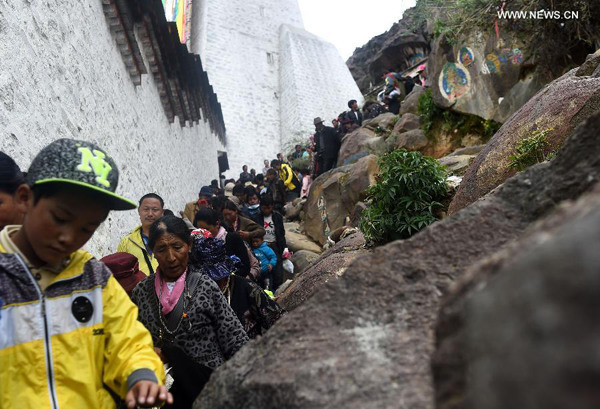 |
|
Tibetan Buddhist believers leave the Tashilhunpo Monastery after attending a Thangka worship activity in Xigaze, southwest China's Tibet Autonomous Region, July 13, 2014. (Xinhua/Jin Liangkuai)
|
Thousands of people gathered to pay homage to the unrolling of the thangka - giant religious silk embroideries - to mark the third day of the Buddha Images Show Festival at the Tashi Lhunpo Monastery in Tibet's Xigaze prefecture on Sunday.
The ritual, which involves the presentation of Buddha images in the monastery, is linked to prayers for rain to deliver a bumper harvest for the local people, religious officials of the monastery said.
The three-day-event is observed annually from the 14th to the 16th days of the fifth month of the Tibetan calendar, according to the monastery.
The first two days displayed images of past Buddha Amida and present Buddha Gautama. The third day displayed the future Buddha Maitreya, said Nyandrak, deputy director of the monastery's management committee.
"The show today is especially important because it celebrates the 11th Panchan Lama's reaching his age of 25," the 70-year-old said on Sunday.
Tibetan Buddhists believe the age of 25 is a hard year. In order to keep away from things in life that would make one vulnerable, Tibetans carry out certain religious rituals at that age, local residents said.
The thangka displayed on Sunday was 45 meters long and 29 meters wide and took 25 tailors and 90 other workers almost seven months to complete.
The monastery is the bed-sitting, or official coronation, place of the successive Panchan Lamas. A similar thangka was displayed for the 9th Panchan Lama at age 37, Nyandrak said.
More than 20,000 Tibetans across the region lined up early in the morning to make the pilgrimage to the Buddha image show.
"I am very pleased to be here to pay homage to the future Buddha. I wish all living beings to be healthy and peaceful," said Tobchen, from Tibet's Rinpung county.
Accompanied by the sound of horns reverberating through the air, monks slowly unrolled the thangka on the mountainside behind the monastery.
Followed by Tibetan Buddhists who offered their white hada - white silk scarves that signify goodwill, purity and good fortune - to the image, the monks prayed in front of the image.
"I am surprised to see such an age-old tradition is still well preserved by local Tibetans, and I am impressed with how Tibetans value this giant artistic work," said Lars Erik, a tourist from Denmark.
We recommend:
